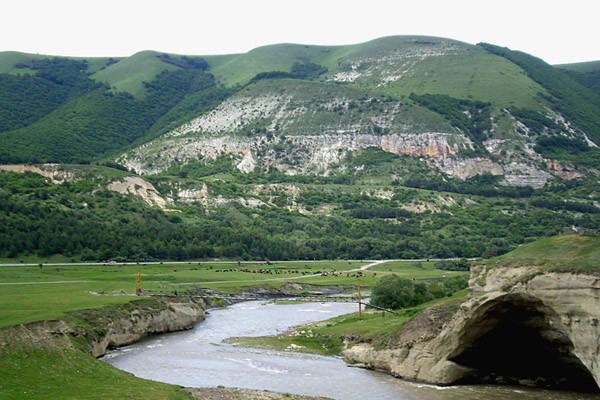Caucasia
Caucasia. A large region between the Black Sea and the Caspian Sea on the border between Eastern Europe and Asia. It is traversed by the Caucasus Mountains, from which it derives its name. In the north, Caucasia extends to the Kuma-Manych Depression and, in the south, to the northwestern border of Turkey and northern border of Iran. The region covers an area of over 440,000 sq km and in 1959 had a population of 27 million. Its northwestern part is settled by Ukrainians.
Caucasia consists of three geographical zones: (1) the steep Caucasus Mountains, known also as the Great Caucasus Range; (2) the steppe lowlands of Subcaucasia, which lies north of the mountains and is divided by the Stavropol Upland into the Kuban Lowland and the Terek-Kuma Lowland (see Terek region); and (3) the mountains of Transcaucasia (the Little Caucasus and the Southern Caucasian or Armenian Highland), which are south of the lowlands and are separated from them by the Rion Depression and the Kura Valley. The Caucasus mountain watershed divides Caucasia into two historical-political regions: (1) Transcaucasia, with an area of 190,000 sq km (encompassing Georgia, Azerbaijan, and Armenia) and a population of 14 million; and (2) Subcaucasia or northern Caucasia, with an area of 250,000 sq km belonging to the Russian Federation (encompassing Krasnodar krai, Stavropol krai, and the republics of Kabardino-Balkaria, North Ossetia, Chechnya, Ingushetia, and Dagestan) and a population of 13 million.
The history and the ethnic composition of Caucasia were determined by its location on the European-Asian frontier. Except for eastern Subcaucasia, with its arid steppes and lowlands of the Caspian littoral, this region was repeatedly crossed by migrating peoples from the East. The mountains served as an obstacle to the migrations and a refuge for many small indigenous peoples. No large and lasting independent states, except Georgia and Armenia, ever arose in Caucasia. The region was usually subject to the political and cultural domination of the neighboring peoples—the Scythians, Huns, Khazars, Persians, Greeks, Romans, Byzantines, Arabs, and Turks. The Mongol invasions of the 13th century and Mongol control of Subcaucasia had a great impact on the region. In the 15th century Caucasia became an object of contention between Iran and Ottoman Turkey. Christianity reached Transcaucasia in the 4th century and Subcaucasia (Taman Peninsula) in the 6th. The Arabs introduced Islam, which by the 18th century was adopted by all the peoples of the region except the Georgians, Armenians, and, partly, the Ossetians. Russia began to expand into the region in the 18th century and by the beginning of the 19th century controlled most of it. In spite of resistance from the Caucasian peoples, the process of conquest was completed by the 1860s and led to an almost full Slavicization of Subcaucasia, where, apart from Dagestan, indigenous peoples account for scarcely one-eighth of the population (see Kuban). In Transcaucasia, however, the population consists mainly of Georgians (3.5 million), Azerbaijanians (over 4 million), and Armenians (2.5 million), with Russians and Ukrainians accounting for over 1 million, or one-tenth of the population.
After the October Revolution of 1917 the independent states of Georgia, Azerbaijan, Armenia (which formed a short-lived federation), and the Republic of Caucasian Mountain Peoples arose in 1918. In 1920–1 these countries were occupied by the Bolsheviks. In 1922 the Transcaucasian SFSR was established, which was divided into three Soviet republics—Azerbaijan, Armenia, and Georgia—in 1936. In 1921–2 Subcaucasia was incorporated into the Gorskaia ASSR as part of the Russian SFSR. Eventually it was divided into a number of autonomous soviet socialist republics and autonomous oblasts (see Caucasian mountain peoples).
Ukrainian contacts with the peoples of Caucasia go back to the Princely era and were renewed in the 19th and particularly the 20th century. They have consisted mostly of contacts with the Georgians and to a lesser extent with the Armenians. Ukrainian deputies worked with Caucasian deputies in the Russian State Duma in the Autonomists' Union. In 1917 representatives of the Caucasian peoples took part in a conference of the captive peoples of Russia, which was held in Kyiv. The Ukrainian National Republic established diplomatic ties with the independent Caucasian states in 1918. Their diplomatic missions abroad (particularly at the Paris Peace Conference) worked closely together to defend their independence. The Ukrainian and the Caucasian governments in exile continued their co-operation: in 1926 the Government-in-exile of the Ukrainian National Republic established an alliance with the Caucasian confederation. The Ukrainian and Caucasian delegations worked closely together at the League of Nations in Geneva. From 1926 they co-operated in the Promethean movement in Warsaw and Paris and, after the Second World War, in the Anti-Bolshevik Bloc of Nations and the Paris Bloc.
Under the Soviet regime Ukrainian-Caucasian contacts were taking place only in the cultural sphere.
Volodymyr Kubijovyč
[This article originally appeared in the Encyclopedia of Ukraine, vol. 1 (1984).]

